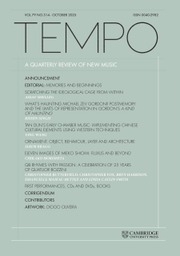No CrossRef data available.
Article contents
THE MICROTONAL PIANO AND THE TUNED-IN INTERPRETER
Published online by Cambridge University Press: 19 December 2019
Abstract
This article forms part of ‘The Microtonal Piano – and the tuned-in interpreter’, an ongoing artistic research project at the Norwegian Academy of Music that seeks to demonstrate how microtonality can increase the expressive possibilities of the acoustic piano. Many different modes of playing can result in microtonal sounds, and this article presents a preliminary overview of these possibilities. For the project, new works have been commissioned from several composers, and different aspects of microtonal modes of playing are integrated into these works. Multiphonics is obviously one of these modes of playing, as it most often results in microtonality. At the end of the article, different ways that multiphonics can be modified when used in combination with some of the other microtonal modes of playing are suggested.
- Type
- RESEARCH ARTICLE
- Information
- Copyright
- Copyright © Cambridge University Press 2019
References
1 ‘Besides ordinario playing, there are both harmonic sounds, tempered chromatic sounds, nontempered sounds, and inharmonic sounds available on the piano to complement or contrast the multiphonics’. Juhani Vesikkala, ‘Multiphonics of the Grand Piano: Timbral Composition and Performance with Flageolets’ (MA Thesis, Sibelius Academy, 2016), pp. 94–5.
2 A piano string course is the 1 or 2 or 3 string(s) corresponding to 1 key on the piano.
3 Shockley, Alan, The Contemporary Piano, A Performer and Composer's Guide to Techniques and Resources (Lanham, MD: Rowman and Littlefield, 2018)Google Scholar.
4 An agraffe is a small part of a grand piano at the tuning-pin end of the string, that works as the termination of the string's vibrating string length.
5 Santiago Diez-Fischer, one poetic switch for solo piano (2014).
6 The term is borrowed from Vesikkala, ‘Multiphonics of the Grand Piano’, p. 90.
7 A link to the audio examples can be found at the end of this article.


